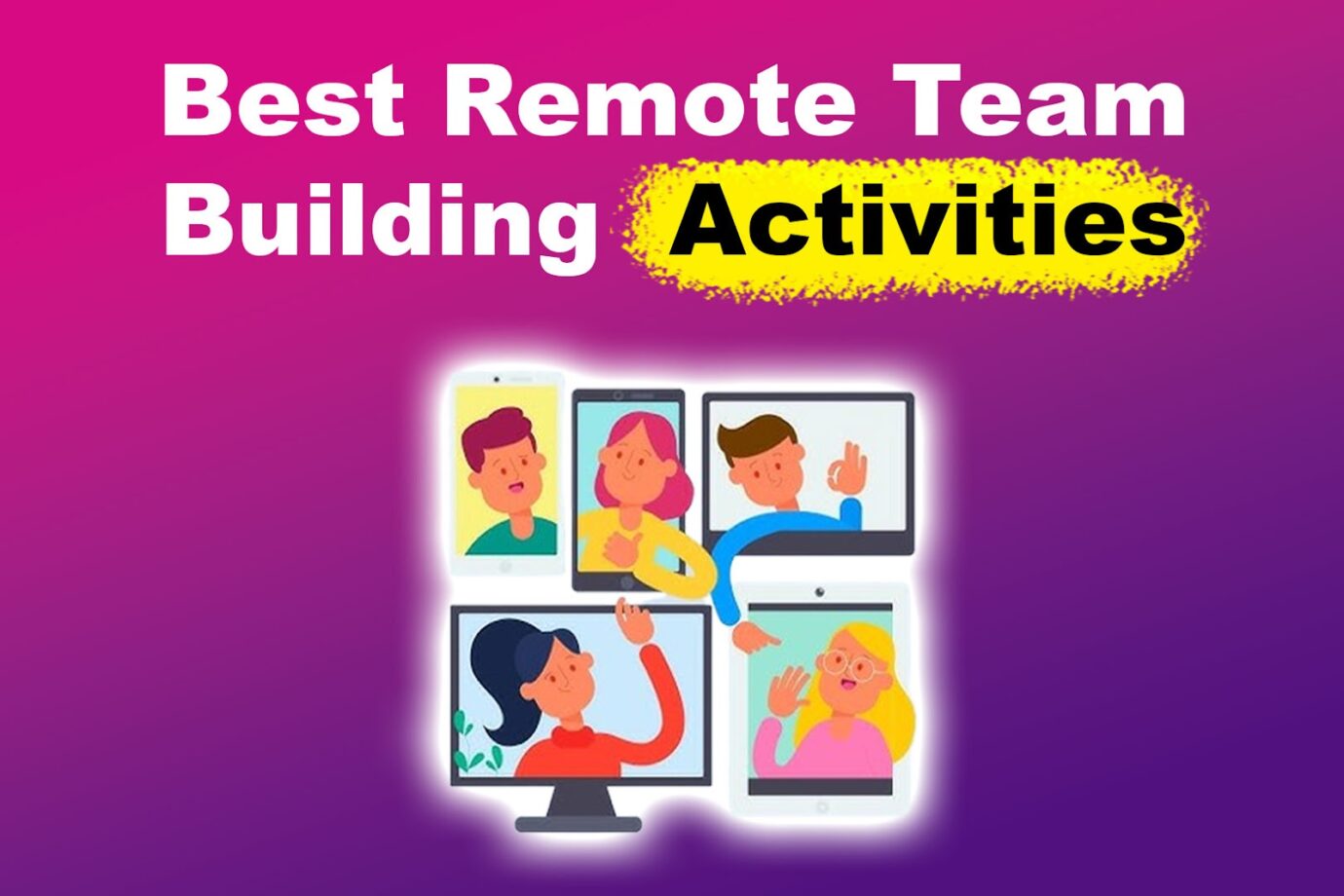Team-building activities have always been essential to organizations. They help form bonds between employees and make them work harmoniously. However, team-building is more of an in-person activity.

So, what if your entire team is working remotely? How can you encourage them to build relationships regardless of the distance? Remote team-building activities exist for this reason.
In this article, we’ll list the most fun and interactive activities your virtual team can participate in!
Why Are Team Building Activities Important?
Communication is challenging when employees don’t see each other face to face. A study by two professors at Ohio State University found that the more a team relies on remote communication tools, the less they trust their coworkers. This is why virtual team activities are crucial.
Here are the reasons why team-building activities are important for remote teams:
- Better Communication.
Team building encourages employees to interact openly. When they are used to communicating, they can express their concerns, suggestions, and thoughts more openly, thus building positive relationships. - Improved Morale.
People who work remotely may feel isolated due to a lack of spontaneous conversations and interactions that are otherwise available in an in-office setting. Team-building activities can make them feel engaged, giving them a sense of connection. - Bridges Physical Distance.
Virtual activities like games and quizzes encourage remote workers to interact. This builds their rapport and camaraderie despite their geographical differences. - Increased Productivity.
A team that works together becomes more productive. This is because it’s easier for them to connect through communication tools, resulting in better cooperation. With better collaboration comes more work done without the employees overworking. - Better Company Culture.
Company culture improves when employees work towards the same goal. Working together to complete virtual team activities can give them a sense of belongingness, which is beneficial once they return to remote work. - Improved Creativity.
Fun remote team-building activities train employees to devise creative solutions to problems. This skill is valuable to learn as it can be used when encountering work-related issues.
Forbes explains why team building is vital for every organization.
18 Remote Team Building Activities
A study conducted by Harvard Business Review revealed that over 40% of respondents from offices in the US experience workplace isolation. If that percentage of workers feel isolated even when working in physical offices, more remote workers will feel the same.
Mutual connection is a crucial part of team success. Therefore, employers and managers must bridge the emotional gap between remote workers. The answer? Remote team building.
Here are 18 of the best remote team-building activities that you can do with your virtual team:
1. Icebreaker

There’s no better way to start any activity than by engaging employees with icebreakers. This helps them overcome their initial awkwardness, making them more willing to participate in the following activities.
When doing icebreaker activities, use the ones that will enhance your team’s participation. For instance, you can ask fun questions, give them riddles to answer, or share fun experiences.
Such activities create a positive team dynamic, allowing them to relax while sharing their thoughts.
Here are some of the engaging icebreaker activities you can use:
- Fun Questions.
Some examples are, “What is the last song you listened to?” and “What is the weirdest thing you searched on Google?” - Rapid Fire Question.
This is an activity where you’ll ask people to choose between two things. The questions are asked consecutively, giving them only a little chance to think of their answer. Example–” Coffee or milk?”, “Cats or dogs?” and “Sweet or salty?”. - Four C’s Icebreaker.
Four C’s means– car, color, cartoon character, and cuisine. To play this, team members should name each one of the Cs that describes them best and explain why those are their answers.
Find out why icebreakers work as a team-building activity in this article by the University of Illinois.
2. Music Hangout

This remote team-building activity encourages collaboration by requiring virtual teams to share their favorite songs. It’s a good way to let employees discover co-workers with the same musical taste. As a result, they become more inclined to interact with them once your team building is over.
You can create a Spotify playlist and ask your team to put some songs in there for better participation.
3. Mini Games
You can now integrate mini-games into video conferencing apps like Zoom and Microsoft Teams. If you don’t have much time to prepare for your remote team-building activity, you can use these online games to establish fun within your team.
These are some of the online mini-games you can play using video conferencing tools:
- Lightning Scavenger Hunts.
In this game, you must ask the players to find what you’ll say and show them to the camera. For instance, you can ask them to hunt for something red, an unusual item, or their favorite book. To win, they should find these things as fast as they can. - Zoom Games.
Zoom has an app marketplace where you can download online games that your team can play. Some of these games include Heads Up, Werewolf Friends, and #AskAway. - Guess the Movie.
To play this game, ask your team to put their mics on mute. Then, play a scene from a movie without revealing its title. The players should place their answers in the Zoom chat box. Whoever answers correctly first wins.
4. Pancakes vs. Waffles
This remote team-building activity works like a team debate. The participants are divided into teams and will choose between the two breakfast staples. They then have to defend their choice in a way that will convince the game master (the managers or employers) that it is indeed the better breakfast.
Pancakes vs. Waffles is ideal for helping your team members exercise their critical thinking, analysis, and persuasion skills. It also helps them become familiar with their virtual team, which can result in them building virtual relationships and making cooperation easier once they are back in the work setting.
5. Virtual Movie Night

Who doesn’t love a good movie? It’s one of the best ways to keep people entertained without preparing a lot.
To choose what to watch for your virtual movie night, create a poll containing a few of the best shows today. Ask your team to cast their votes so they have input on what they will watch.
You may think watching a movie is not interactive. However, you can add mini-activities before and after the show. For instance, before starting the movie, ask the participants to share what they’re having for snacks or what they think will happen to the movie characters.
You can also discuss how the movie went after it ends with your team. Ask them if they were satisfied with the ending or if there’s any fun fact they know about the characters.
Check out Time Magazine’s list of 100 best movies for the past 10 years.
6. Virtual Escape Rooms
Virtual escape rooms are a great way to develop team camaraderie while practicing problem-solving skills. Escape rooms are time-sensitive, making them fun to do. Teams must figure out how to solve a puzzle or open a treasure chest quickly.
The time-sensitive nature of the game stimulates teamwork as players enjoy it. To inspire your virtual team to participate, offer a prize, such as a gift card or a lunch incentive, to the winning team.
These are some of the virtual escape rooms you can integrate into your remote team-building activities:
- The Grimm Escape.
This game is set in a fairytale land where players must solve riddles and escape in an hour. However, this isn’t a free escape room, so you must pay $25 per participant. - Trapped in the Web.
In this game, teams must search the World Wide Web for clues. You can choose various escape room settings, including outer space, a school, and a cruise ship cabin. Like The Grimm Escape, Trapped in the Web is a paid game. The price depends on the escape room you choose.
7. Weird Holidays
Holidays are typical of any workplace. The 4th of July, Christmas, or New Year’s Day– name it, every remote worker knows it. But have you heard of weird holidays?
Celebrating weird holidays can bring your team much fun and new learning. While it may seem unusual to some, weird holidays have historical, cultural, and traditional significance.
So, celebrating it as a quick team-building activity will allow everyone to learn about another country’s traditional practices.

Here are some of the weird holidays you can celebrate with your virtual team:
- International Fun at Work Day.
Celebrated every April 1st, this holiday aims to make workplaces a healthier environment for employees. So, during this day, and even after, ensure you share a good laugh with your team to help them interact. - Eat a Red Apple Day.
As the name suggests, this holiday encourages everyone to eat an apple. It’s a movement started by Bowel Cancer Australia to spread health awareness. Eat a Red Apple Day is celebrated on December 1st. - Ditch New Year’s Resolution Day.
Everyone knows how difficult it can be to follow a New Year’s Resolution. In fact, relevant studies found that only about 9% of people in the US can follow their resolutions. This holiday is celebrated every January 17th. To celebrate it with your virtual team, you can ask them to share their resolutions and why they ditched them.
Whatever weird holiday you celebrate, you can add any touch of interaction. Choose a fun holiday so you and your team can enjoy the day, even if it’s only a virtual team-building activity.
8. Two Truths and a Lie
Who will ever forget this good old game? Two Truths and a Lie is a fun way to introduce your team members to one another. To play, your team members should write two truths and a lie about themselves. The funnier what they write is, the better.
Then, choose facts to read and have the participants guess which one is a lie. The winner is whoever guesses the most lies.
9. Put a Finger Down
This mini-game is trending on social media. It starts with all the participants holding five fingers up. Then, each member should take turns saying fun facts about themselves. For instance, if the player says, “Put a finger down if you’re allergic to seafood,” those who are also allergic should put their fingers down.
Put a Finger Down will let your team discover co-workers with whom they have similarities. This will allow them to connect with those who can vibe with them and learn something new about the ones they haven’t interacted with yet.
10. Virtual Ambassadors

In this remote team-building activity, each team member will roleplay as an ambassador of a country assigned to them. They should describe their country without saying its name and make the other participants guess it. You can even level up the game’s difficulty by requiring players to act instead of describing their countries.
For example, if a player’s country is Australia, they can mimic a kangaroo’s movement to describe it. To make your virtual team interested in playing, you can give a prize to whoever has the most correct guesses.
11. The Longest Word
Ever heard of “supercalifragilisticexpialidocious?” What about “pneumonoultramicroscopicsilicovolcanoconiosis?” These words are more challenging to spell than to say, making them a fun game for your next team building.
The Longest Word is the same as a spelling bee, except players need to spell super-long words they may not be familiar with. Of course, you can’t expect them to spell the long words correctly to win. Instead, whoever has the closest spelling to the correct one earns a point.
Grammarly lists the longest words in the English dictionary that you can use for this game.
12. Remote Lunch
Who says only those who work in physical offices can experience pantry banter? Having a remote team lunch lets your virtual team enjoy chatting while munching on their favorite meal.
If you only have a small team or a budget, you can shoulder each team member’s meal and deliver it to their address. Otherwise, you can ask them to prepare their own. To make things more fun, include a requirement for what meal they should prepare. For instance, their food should be red, cold, or spicy.
13. Guess the Background

This remote team-building activity involves adding a background in Zoom. You can set a requirement when choosing a background, such as popular places in the world or characters from a movie.
Once it’s game time, choose a player who will first guess a background. The team members then take turns guessing, and whoever has the most points wins.
Zoom has many great virtual backgrounds you and your team can use.
14. Object Memory
Object memory will test who among your virtual team has the sharpest memory. To play this game, separate your team members into a few groups.
Next, list 20 or more words on a virtual whiteboard and screenshare for half a minute. Each team should memorize as many words as possible within those 30 seconds.
Don’t know how to use Zoom’s virtual whiteboard? Find out in this article.
Finally, give them a few minutes to write down their remembered words.
This game develops teamwork. Even if your team has not interacted yet, they will participate to bring their group victory.
15. Word Association
This is one of the oldest but most effective remote team-building activities for unleashing your virtual team’s creativity.
Group your virtual team into two and give them a word. The playing team should say what first comes to their mind when they think of that word, while the opposing team should associate these descriptions until they can guess the word being described.
Word Association helps your virtual team relax. Once you are all back at work, it will be easier for your team to approach each other when working on tasks.
16. What Would You Do?

Do you have crazy scenarios in mind? You will be able to use that in this remote team-building activity. For this activity, you will only need a few hypothetical questions, such as “If you can taste the weather, what would be the worst-tasting weather for you and why?”.
Once you have stated a hypothetical question, give your virtual team a few minutes to think of a solution. Finally, each member should discuss what they would do in the situation.
This activity fosters team engagement and lets you observe which virtual team members have good problem-solving skills. Who knows? You might even find the next team leader while playing this game.
17. Get to Know Each Other
This activity requires you to divide your team into small groups. If you have a small team, you can pair them. Meanwhile, larger teams can have groups of three or four people.
As the name suggests, Get to Know Each Other aims to connect team members. They must creatively introduce themselves once they are in their group’s meeting room. This ensures everyone’s participation so that no one is left behind.
Another effective game to help your team get to know each other is “Would You Rather.” Here are 101 “Would You Rather” questions for work!
18. Meme Day

Who doesn’t love memes? No one. So, set a day when your team can send memes to your chat. Ask your team members to use the funniest meme they have for this remote team-building activity to give everyone some fun.
To decide who the winner is, ask the remote team to react to the meme they laughed at the most. This will give them a few minutes of a break from their tasks, allowing them to refresh their minds and consider new perspectives.
What Are the 5 Cs of Team Building?
The 5 Cs of team building are Communication, Collaboration, Confidence, Commitment, and Coachability. These factors are essential for a productive team, as they can interact to develop team strength.
When developing a virtual team-building activity, ensure that your activities promote these five Cs. This will ensure that team-building will yield positive results and make your team more comfortable with each other.
It’s worth noting that even when the team building is over, you should still put these five elements in place. They can help each of your team members reach their full potential, giving them a chance to learn more while working at home.
Remote Team Building Makes Teams More Powerful
Just because a workplace team doesn’t work together physically doesn’t mean they don’t need to interact. This physical distance is the main reason why virtual employees find it hard to approach their workmates.
Fortunately, virtual team-building can bridge this gap. It removes your team members’ awkwardness, making it easier for them to ask for help when working.